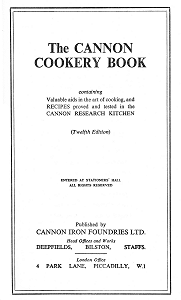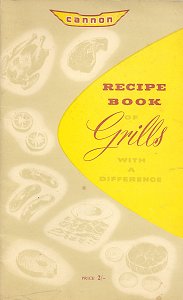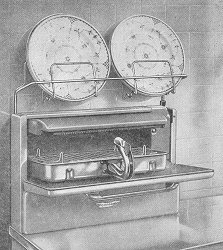|
Cannon Iron Foundries Ltd had their origins in the middle of the
nineteenth century and had their head offices and works at
Deepfields, Bilston. They made all sorts of cast iron
goods, especially cooking pots, saucepans, frying pans and the
like. When gas cookers started to come into use they made
them too and became one of the biggest and best known suppliers
of them. It became the practice to give away a cookery
book with each new cooker. This was probably needed
originally because cooking with gas was somewhat different from
cooking on a range or open fire. On the up side, it was
much easier to start up and switch off; you could control the
heat much more accurately; and you could maintain that accuracy
over a period of time. On the downside, you only had,
usually, one oven space; and you could not vary the heat for
different items by using different ovens for different foods nor
by moving the food closer to or further away from the fire on a
trivet or jack; the best you could do was to make some use
of the temperature gradient between the top and the bottom of
the oven.

The title page of the Cannon
Cookery Book |
The Cannon Cookery Book on display here (the
title at the top of the page comes from the cover) is the
12th edition, dated May 1950. The first edition was
issued in June 1932. All the recipes are said to have
been "proved and tested in the Cannon Research Kitchen".
The curious result of all this is that Bilston, not usually
known as a gastronomic centre, probably produced more cook
books and recipes, and had a greater influence on cooking,
than most other places in the country. Its main rival
must have been the Radiation cookery book, which was
produced by another oven manufacturer, New World.
The recipe book contains instructions on how to use the
cooker, as well as extensive notes on general cookery
principles. But the bulk of it is made up of
several hundred recipes, as well as a special section on
Christmas Dinner and another section on how to cook
complete meals on only one setting of the thermostat -
the "Autimo Controller". |
The book is intended to allow for beginners,
though it does not actually contain instruction on how to boil
an egg. But just about everything that was standard family
fare in the 1950s is there, including some recipes that reflect
war time shortages and rationing. What is not there is
probably more noticeable. There is one mention of macaroni
but nothing about spaghetti or pizza, one mention of curry
powder (for a rechauffe fish dish) but nothing more about Indian
food; and there is certainly nothing about sauerkraut, and
anyone interested in French haute cuisine would not find much of
interest in it. The recipes below are ones which might
awaken memories of the way we used to eat.
Stewed Tripe and Onions
| 1 lb tripe |
1 oz butter |
| 2 large onions |
1 oz cornflour |
| 0.5 pint water |
salt and pepper |
| 0.5 pint milk |
|
Peel and cut up onions, put in a stewpan with
cold water, bring to the boil, drain off water. Add tripe
cut up into neat pieces, pour over the 0.5 pint of water, simmer
gently for three-quarters of an hour. Blend cornflour with milk,
add to the stew and allow to cook ten minutes. Add butter
and seasonings to taste and serve.
Sugarless Cake
| 4 oz margarine |
0.5 lb self raising flower |
| 4 oz sweetened condensed milk |
Little milk |
| Pinch salt |
4 oz sultanas |
| 2 dried eggs (reconstituted) |
0.125 teaspoon ground cinammon |
Cream margarine and condensed milk together,
warming a little if necessary. Beat in the eggs gradually.
Mix flour, salt and spice together and stir into creamed
mixture, adding a little milk if required. Stir in the
fruit. Bake in a greased tin, in centre of oven about one
hour with "Autimo" set at Mark 3. Semolina
Pudding
| 1 oz castor sugar |
1 egg |
| 1 pint milk |
strip of lemon rind |
| 1 oz semolina |
or a little cinnamon |
Put the milk on the boil with the strip of lemon
rind or cinnamon. When boiling sprinkle in the semolina.
Simmer very slowly until the semolina thickens and is cooked.
The time required is about 15 minutes. Remove the lemon
rind or cinnamon, add the sugar, stir in the yolk of egg; whip
up the white stiffly and fold into the mixture. Pour the
contents of the saucepan into a pie dish, bake in a moderate
oven until slightly brown with the "Autimo" set at 2.
Trifle
| 6 - 8 sponge cakes |
1 tin pears |
| 1 packet raspberry jelly |
wine, if liked |
| 0.5 pint custard |
1 small tin of rapsberries |
| 3 tablespoons raspberry jam |
|
I cannot be bothered to give the method which
appears in the Cannon cook book. This is not trifle but a
sort of raspberry jelly with cake and custard. Mrs. Beeton
would have thrown a fit. The recipe shows the boring
condition which British cookery had got into in the 1950s.
 |
Things gradually improved. This
recipe book is undated but is from the late 1950s or
early 1960s. It is confined to recipes for
grilled food because Cannon had introduced the Foldaway
High Level Grill. Up to this time the salamander
and grill pan had been between the hobs and the oven;
and it was impossible to see what was going on without
either bending down or pulling out the grill pan.
The eye level grill was a marked improvement. The
grill pan was not only visible but filled the whole
width of the oven; and it had a rack which could
be placed at any one of seven different levels.
When the grill was not in use it could be folded up
completely or just the lower tray could be put in
position for such uses as keeping saucepans warm. |
| The recipe book starts by announcing that
"a doctor will tell you that a grill is more easily
digested" and that grilled food is excellent for those
on a low-fat diet. The recipes are notably more
oriented towards French cuisine - or, at least, are
pretending to be.
The book starts with Bordeaux
Eggs, Eggs a la Bercy and even Eggs a la Portugaise.
Later there is Lobster en Brochette and Russian Kebabs
and, in a flight of fancy, Quails a la Crapaudine - a
dish which would not, at that time, have been offered in
many of the cafes of Bilston. |
 |
|